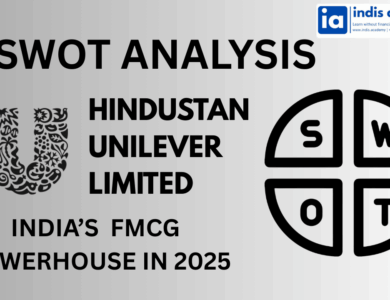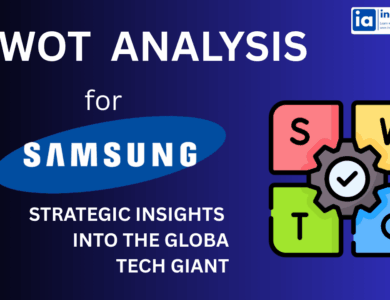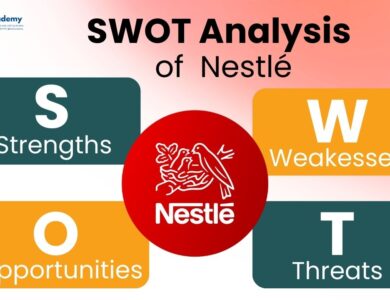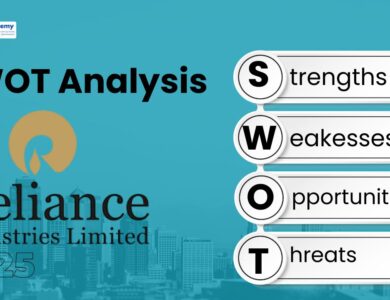HDFC Bank SWOT Analysis: A Strategic Overview of India’s Banking Giant
Discover how HDFC Bank is navigating the banking landscape in 2025 with our SWOT analysis, examining its core competencies and areas for improvement.
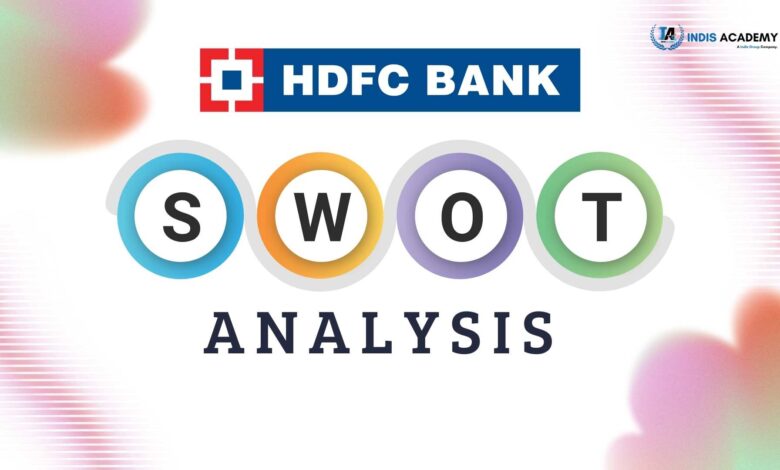
India’s banking sector has witnessed remarkable transformation over the past few decades, and one name that consistently stands out is HDFC Bank.
Known for its customer-centric approach, robust digital infrastructure, and reliable financial performance, HDFC Bank has become a household name and a market leader in private banking.
But what makes HDFC Bank such a giant in this competitive industry? And more importantly—what strengths fuel its growth, what weaknesses hold it back, and what opportunities or threats lie ahead?
In this detailed SWOT analysis of HDFC Bank, we’ll take a closer look at the strategic factors driving the bank’s success and the challenges it must navigate to stay ahead. Whether you’re an investor, business student, or banking professional, this breakdown will give you a clear and practical overview.
Ready to dive in? Let’s first understand where HDFC Bank stands in today’s financial landscape.
Also Read: Complete SWOT Analysis of Zomato – How It Dominates the Food Delivery Market
Learn AI & Digital Marketing,
Pay Fees After Placement
- ✅ Minimal Admission Fees
- ✅ No Loan or Income Sharing Agreement
- ✅ 100% Placement Support
- ✅ ISO & Govt Registered Certificate
- ✅ Practical 3+1 Months Duration
Get a free counseling call. We’ll guide you through learning, certification, and job placement.
Request a Free Call Back
Takes less than a minute.
Company Overview of HDFC Bank
Founded in 1994, HDFC Bank is one of India’s largest and most trusted private sector banks. Headquartered in Mumbai, the bank has consistently maintained a leadership position in both retail and wholesale banking.
As of 2025, HDFC Bank operates across 7,500+ branches and 19,000+ ATMs in over 3,200 cities and towns in India. Its extensive reach allows it to serve millions of customers, from metro cities to emerging rural regions.
HDFC Bank offers a wide range of services, including:
- Savings & current accounts
- Loans (home, personal, auto)
- Credit cards and payment solutions
- Digital banking (NetBanking, MobileBanking, PayZapp)
- Wealth management, insurance, and investment services
Following the HDFC Ltd and HDFC Bank merger in 2023, the bank significantly strengthened its portfolio in the housing finance and long-term loan segment—positioning itself as a one-stop financial solution provider.
Today, HDFC Bank is not just a bank—it’s a brand built on trust, performance, and innovation.
What is a SWOT Analysis?
A SWOT analysis is a strategic planning tool used to evaluate an organization’s Strengths, Weaknesses, Opportunities, and Threats. It helps understand both internal capabilities and external risks.
For a banking giant like HDFC Bank, SWOT analysis reveals:
- What the bank does exceptionally well
- Areas where it can improve
- Emerging market opportunities it can leverage
- Potential challenges that could impact its growth
Whether you’re an investor studying the bank’s future, a student preparing for an MBA case study, or a business leader benchmarking the competition—SWOT is your go-to tool for insight and clarity.
Now that we’ve set the foundation, let’s dive into what makes HDFC Bank one of India’s most powerful financial institutions.
Also Read: Complete SWOT Analysis of Mahindra – How the Brand Continues to Lead the Indian Market
Strengths of HDFC Bank
HDFC Bank’s strengths have not only helped it maintain dominance in India’s private banking sector, but have also made it a trusted name for millions of customers. Let’s explore what sets it apart:
1. Strong Brand Reputation & Customer Trust
HDFC Bank has built a solid brand over the years. Its consistent service quality, transparency, and customer satisfaction have earned it the trust of both retail and corporate clients.
In surveys and industry rankings, HDFC often tops the list of “Most Trusted Private Banks in India.” This trust directly contributes to customer retention and steady business growth.
2. Robust Digital Banking Ecosystem
The bank has been a digital pioneer. Its platforms like NetBanking, MobileBanking, PayZapp, and SmartHub have revolutionized how customers interact with banking services.
It handles over 90% of transactions digitally, reducing operational costs while offering speed, convenience, and security.
3. Extensive Branch & ATM Network
HDFC Bank operates over 7,500+ branches and 19,000+ ATMs, offering unparalleled reach across India.
Whether in tier-1 cities or smaller towns, customers have access to reliable physical banking infrastructure, which adds to its hybrid strength—digital + physical.
4. Consistent Financial Performance
HDFC Bank has shown stable growth in revenue and net profit year after year. Even during economic slowdowns, it managed to post positive results.
In FY 2023-24, the bank reported a net profit of over ₹50,000 crore, backed by healthy interest margins, strong asset quality, and a growing loan portfolio.
5. Low NPAs and Efficient Risk Management
While many banks struggle with non-performing assets (NPAs), HDFC maintains one of the lowest NPA ratios in the Indian banking sector—thanks to strong due diligence and risk controls.
This financial discipline ensures long-term stability and investor confidence.
6. Strategic Merger with HDFC Ltd
The 2023 merger with HDFC Ltd turned the bank into a housing finance powerhouse. It now has better cross-selling capabilities, access to long-term capital, and a diversified lending book.
This move is expected to unlock massive synergies over the next few years.
Competitor Comparison Table
Here’s how HDFC Bank stacks up against top Indian banks:
| Bank Name | Net Profit (FY24) | Branches | NPA Ratio | Digital Adoption |
|---|---|---|---|---|
| HDFC Bank | ₹50,000 Cr+ | 7,500+ | ~1.2% | 90%+ |
| ICICI Bank | ₹38,000 Cr+ | 6,200+ | ~2.0% | 85%+ |
| SBI (Public) | ₹60,000 Cr+ | 22,000+ | ~3.0% | 70%+ |
| Axis Bank | ₹28,000 Cr+ | 4,800+ | ~2.4% | 80%+ |
Note: Data is indicative and based on 2023-24 financial reports.
Also Read: Sony SWOT Analysis: Key Business Strategies & Market Challenges
Weaknesses of HDFC Bank
Despite its dominant position, HDFC Bank isn’t without its challenges. Understanding its internal limitations is crucial to assess its overall strategic standing. Let’s explore some key weaknesses:
1. Overdependence on Urban Markets
A large chunk of HDFC Bank’s business comes from metro and tier-1 cities. This urban-centric focus makes it vulnerable to regional economic fluctuations and leaves rural market potential underutilized.
While public banks like SBI have deeper rural penetration, HDFC is still catching up in rural financial inclusion.
2. Limited Global Presence
Unlike global banks or even Indian counterparts like SBI (with international branches), HDFC Bank has a minimal presence outside India. This restricts access to global banking opportunities and makes it more dependent on domestic economic trends.
3. Digital System Outages
While HDFC leads in digital banking, it has also faced criticism for frequent tech outages. There have been multiple incidents of mobile banking, net banking, and UPI services going down—affecting user trust and operational continuity.
The RBI even temporarily banned HDFC from issuing new credit cards in 2020 due to these glitches.
4. Aggressive Cross-Selling Practices
The bank has faced backlash for aggressively pushing credit cards, insurance, and loans to its existing customers. While cross-selling drives revenue, it can sometimes lead to poor customer experience and dissatisfaction.
5. High Operating Costs
Due to its wide service network and continued investments in tech, compliance, and staffing, HDFC Bank carries relatively higher operational expenses than some fintech-first banks. This affects its cost-to-income ratio, especially when margins tighten.
While these weaknesses don’t overshadow HDFC’s strengths, they serve as reminders that even market leaders must evolve to stay relevant and efficient.
Also Read: Royal Enfield SWOT Breakdown: How the Brand Dominates the Mid-Size Bike Market
Opportunities for HDFC Bank
The future holds significant potential for HDFC Bank, both in terms of business expansion and innovation. By leveraging its strengths and responding to market shifts, the bank can tap into these growth avenues:
1. Expanding in Tier-2 and Tier-3 Cities
As urban markets begin to saturate, semi-urban and rural areas represent untapped potential. With rising financial literacy and digital penetration, HDFC can grow its customer base by opening smart branches and expanding mobile services in smaller towns.
This move can also balance its current urban-heavy business model.
2. Partnerships with Fintech Startups
India’s fintech ecosystem is booming, and HDFC Bank has the resources to partner or invest in agile fintech players. Collaborations in areas like BNPL (Buy Now, Pay Later), embedded finance, and AI-powered lending can boost product innovation and reach.
3. Cross-Selling Post Merger with HDFC Ltd
The 2023 merger created India’s first true financial services superpower. Now, HDFC Bank can offer:
- Home loans
- Mutual funds
- Life and health insurance
- Investment planning
…all under one umbrella. This opens a huge cross-selling window, especially with over 7 crore customers in its ecosystem.
4. International Expansion
Although currently focused on India, there’s scope for the bank to expand services for Non-Resident Indians (NRIs) or even open select branches in international markets—especially where Indian expats have a strong presence (e.g., UAE, UK, USA).
5. Digital Transformation & AI Adoption
With increasing competition from digital-first banks and UPI-based apps, HDFC can further strengthen its AI, analytics, and automation strategy.
From personalized product recommendations to AI-based fraud detection, the future lies in becoming more intelligent and adaptive.
6. Growing MSME & Startup Lending
India’s small businesses are a massive lending opportunity. By creating customized lending products for MSMEs, freelancers, and startups, HDFC Bank can increase its loan book while supporting India’s entrepreneurial wave.
In short, HDFC Bank is perfectly placed to scale both horizontally and vertically—if it capitalizes on these evolving market trends.
Threats to HDFC Bank
While HDFC Bank stands strong today, it faces several external threats that could impact its market dominance if not managed proactively. Let’s break them down:
1. Rising Competition from Fintech & Digital-Only Banks
With platforms like RazorpayX, Paytm Payments Bank, PhonePe, and neo-banks entering the market, customers now have faster, cheaper, and more tech-driven options.
These agile competitors target millennials and digital-first users, potentially eating into HDFC’s younger customer base.
2. Regulatory Challenges & RBI Scrutiny
The Reserve Bank of India (RBI) has increased its oversight of private banks, especially after digital outages and compliance gaps.
Stringent norms on credit cards, lending, data privacy, and digital infra could slow down HDFC’s innovation speed or require costly upgrades.
3. Cybersecurity Threats
As banking goes digital, cyberattacks and data breaches are growing risks. One large-scale breach can not only cause financial loss but also erode brand trust.
HDFC must invest heavily in cybersecurity infrastructure and customer education to stay ahead.
4. Economic Slowdowns & Inflation
India’s economy is vulnerable to factors like inflation, fuel price hikes, and global recession fears.
Such downturns can increase loan defaults, reduce deposit volumes, and affect the bank’s profitability and credit growth.
5. Geopolitical & Global Market Risks
Although HDFC Bank is India-focused, global events like oil wars, trade conflicts, or pandemics can still indirectly hurt its business—especially through currency fluctuations, investor sentiment, or rising interest rates.
These threats highlight the need for constant agility, compliance, and innovation—even for a banking giant.
Strategic Insights & Key Takeaways
HDFC Bank’s current market position is undoubtedly strong, but the real game lies in how it evolves from here.
To maintain and expand its leadership, the bank must:
- Leverage its merger with HDFC Ltd by cross-selling housing and financial products through one unified platform.
- Go deeper into tier-2/3 markets, tapping rural customers through digital-first solutions.
- Strengthen cybersecurity and IT infrastructure to prevent outages and maintain RBI’s trust.
- Partner with fintechs instead of competing with them—co-create solutions, don’t just replicate them.
- Focus on sustainable lending and MSMEs, aligning with India’s growth trajectory.
In essence, HDFC Bank must balance technology, trust, and reach to future-proof its business. It has the brand, the balance sheet, and the customer base—it just needs to move faster than the market changes.
Conclusion
HDFC Bank’s journey from a private player in 1994 to becoming India’s most valuable private sector bank is nothing short of inspiring. Its focus on customer satisfaction, digital excellence, and financial discipline has helped it gain the trust of millions.
But in a rapidly changing financial world, resting on past laurels is not enough. The bank must keep adapting—by embracing fintech collaboration, expanding rural outreach, and preparing for tighter regulations.
The SWOT analysis reveals that while HDFC Bank has strong fundamentals, its real strength lies in its ability to evolve.
If it continues to innovate while staying customer-focused, HDFC Bank is well-positioned to lead India’s banking revolution well into the future.
FAQs – HDFC Bank SWOT Analysis
1. What are the biggest strengths of HDFC Bank?
HDFC Bank’s strengths include a strong brand image, wide branch network, excellent digital infrastructure, and consistent financial performance.
2. What are the major weaknesses of HDFC Bank?
Its urban-centric focus, limited global presence, and occasional tech outages are key internal weaknesses.
3. Is HDFC Bank facing strong competition?
Yes, the bank faces growing competition from other private banks like ICICI and Axis, and also from fintech platforms like Paytm, RazorpayX, and neo-banks.
4. What future opportunities can HDFC Bank explore?
Expanding into rural markets, collaborating with fintechs, and cross-selling financial products post-merger with HDFC Ltd are major opportunities.
5. Is HDFC Bank a good long-term investment?
Given its fundamentals, brand reputation, and adaptability, many analysts consider it a strong long-term bet—but like any investment, it carries risks.
